Kyle Jamieson
Legilimens: Performant Video Analytics on the System-on-Chip Edge
Apr 29, 2025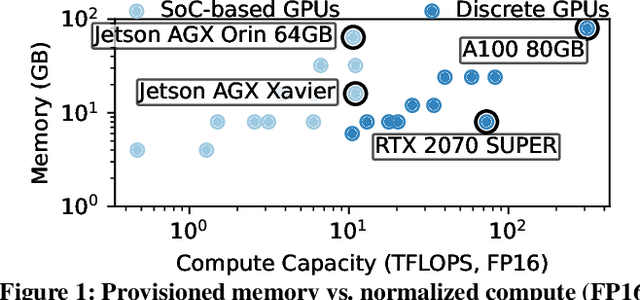

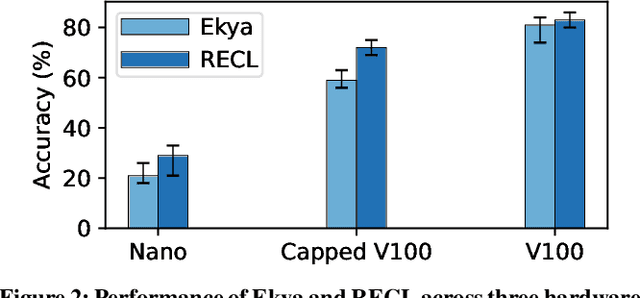
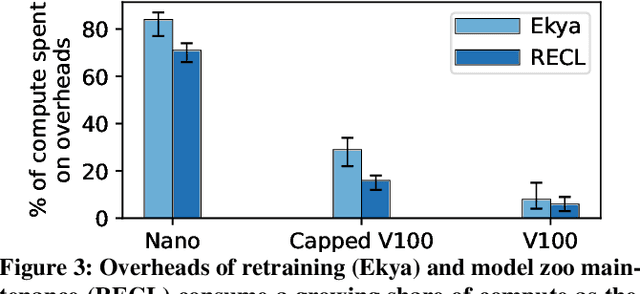
Abstract:Continually retraining models has emerged as a primary technique to enable high-accuracy video analytics on edge devices. Yet, existing systems employ such adaptation by relying on the spare compute resources that traditional (memory-constrained) edge servers afford. In contrast, mobile edge devices such as drones and dashcams offer a fundamentally different resource profile: weak(er) compute with abundant unified memory pools. We present Legilimens, a continuous learning system for the mobile edge's System-on-Chip GPUs. Our driving insight is that visually distinct scenes that require retraining exhibit substantial overlap in model embeddings; if captured into a base model on device memory, specializing to each new scene can become lightweight, requiring very few samples. To practically realize this approach, Legilimens presents new, compute-efficient techniques to (1) select high-utility data samples for retraining specialized models, (2) update the base model without complete retraining, and (3) time-share compute resources between retraining and live inference for maximal accuracy. Across diverse workloads, Legilimens lowers retraining costs by 2.8-10x compared to existing systems, resulting in 18-45% higher accuracies.
Wall-Street: Smart Surface-Enabled 5G mmWave for Roadside Networking
May 10, 2024



Abstract:5G mmWave roadside networks promise high-speed wireless connectivity, but face significant challenges in maintaining reliable connections for users moving at high speed. Frequent handovers, complex beam alignment, and signal attenuation due to obstacles like car bodies lead to service interruptions and degraded performance. We present Wall-Street, a smart surface installed on vehicles to enhance 5G mmWave connectivity for users inside. Wall-Street improves mobility management by (1) steering outdoor mmWave signals into the vehicle, ensuring coverage for all users; (2) enabling simultaneous serving cell data transfer and candidate handover cell measurement, allowing seamless handovers without service interruption; and (3) combining beams from source and target cells during a handover to increase reliability. Through its flexible and diverse signal manipulation capabilities, Wall-Street provides uninterrupted high-speed connectivity for latency-sensitive applications in challenging mobile environments. We have implemented and integrated Wall-Street in the COSMOS testbed and evaluated its real-time performance with four gNBs and a mobile client inside a surface-enabled vehicle, driving on a nearby road. Wall-Street achieves a 2.5-3.4x TCP throughput improvement and a 0.4-0.8x reduction in delay over a baseline 5G Standalone handover protocol.
Optimizing Reconfigurable Antenna MIMO Systems with Coherent Ising Machines
Mar 19, 2024Abstract:Reconfigurable antenna multiple-input multiple-output (MIMO) is a promising technology for upcoming 6G communication systems. In this paper, we deal with the problem of configuration selection for reconfigurable antenna MIMO by leveraging Coherent Ising Machines (CIMs). By adopting the CIM as a heuristic solver for the Ising problem, the optimal antenna configuration that maximizes the received signal-to-noise ratio is investigated. A mathematical framework that converts the selection problem into a CIM-compatible unconstrained quadratic formulation is presented. Numerical studies show that the proposed CIM-based design outperforms classical counterparts and achieves near-optimal performance (similar to exponentially complex exhaustive searching) while ensuring polynomial complexity.
WaveFlex: A Smart Surface for Private CBRS Wireless Cellular Networks
Oct 17, 2023



Abstract:We present the design and implementation of WaveFlex, the first smart surface that enhances Private LTE/5G networks operating under the shared-license framework in the Citizens Broadband Radio Service frequency band. WaveFlex works in the presence of frequency diversity: multiple nearby base stations operating on different frequencies, as dictated by a Spectrum Access System coordinator. It also handles time dynamism: due to the dynamic sharing rules of the band, base stations occasionally switch channels, especially when priority users enter the network. Finally, WaveFlex operates independently of the network itself, not requiring access to nor modification of the base station or mobile users, yet it remain compliant with and effective on prevailing cellular protocols. We have designed and fabricated WaveFlex on a custom multi-layer PCB, software defined radio-based network monitor, and supporting control software and hardware. Our experimental evaluation benchmarks an operational Private LTE network running at full line rate. Results demonstrate an 8.50 dB average SNR gain, and an average throughput gain of 4.36 Mbps for a single small cell, and 3.19 Mbps for four small cells, in a realistic indoor office scenario.
Uplink MIMO Detection using Ising Machines: A Multi-Stage Ising Approach
Apr 25, 2023Abstract:Multiple-Input-Multiple-Output~(MIMO) signal detection is central to every state-of-the-art communication system, and enhancements in error performance and computation complexity of MIMO detection would significantly enhance data rate and latency experienced by the users. Theoretically, the optimal MIMO detector is the maximum-likelihood (ML) MIMO detector; however, due to its extremely high complexity, it is not feasible for large real-world communication systems. Over the past few years, algorithms based on physics-inspired Ising solvers, like Coherent Ising machines and Quantum Annealers, have shown significant performance improvements for the MIMO detection problem. However, the current state-of-the-art is limited to low-order modulations or systems with few users. In this paper, we propose an adaptive multi-stage Ising machine-based MIMO detector that extends the performance gains of physics-inspired computation to Large and Massive MIMO systems with a large number of users and very high modulation schemes~(up to 256-QAM). We enhance our previously proposed delta Ising formulation and develop a heuristic that adaptively optimizes the performance and complexity of our proposed method. We perform extensive micro-benchmarking to optimize several free parameters of the system and evaluate our methods' BER and spectral efficiency for Large and Massive MIMO systems (up to 32 users and 256 QAM modulation).
Cross-Link Channel Prediction for Massive IoT Networks
Dec 15, 2022



Abstract:Tomorrow's massive-scale IoT sensor networks are poised to drive uplink traffic demand, especially in areas of dense deployment. To meet this demand, however, network designers leverage tools that often require accurate estimates of Channel State Information (CSI), which incurs a high overhead and thus reduces network throughput. Furthermore, the overhead generally scales with the number of clients, and so is of special concern in such massive IoT sensor networks. While prior work has used transmissions over one frequency band to predict the channel of another frequency band on the same link, this paper takes the next step in the effort to reduce CSI overhead: predict the CSI of a nearby but distinct link. We propose Cross-Link Channel Prediction (CLCP), a technique that leverages multi-view representation learning to predict the channel response of a large number of users, thereby reducing channel estimation overhead further than previously possible. CLCP's design is highly practical, exploiting channel estimates obtained from existing transmissions instead of dedicated channel sounding or extra pilot signals. We have implemented CLCP for two different Wi-Fi versions, namely 802.11n and 802.11ax, the latter being the leading candidate for future IoT networks. We evaluate CLCP in two large-scale indoor scenarios involving both line-of-sight and non-line-of-sight transmissions with up to 144 different 802.11ax users. Moreover, we measure its performance with four different channel bandwidths, from 20 MHz up to 160 MHz. Our results show that CLCP provides a 2x throughput gain over baseline 802.11ax and a 30 percent throughput gain over existing cross-band prediction algorithms.
mmWall: A Reconfigurable Metamaterial Surface for mmWave Networks
Feb 02, 2021
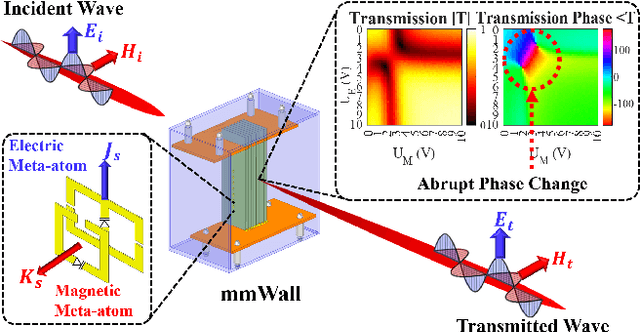
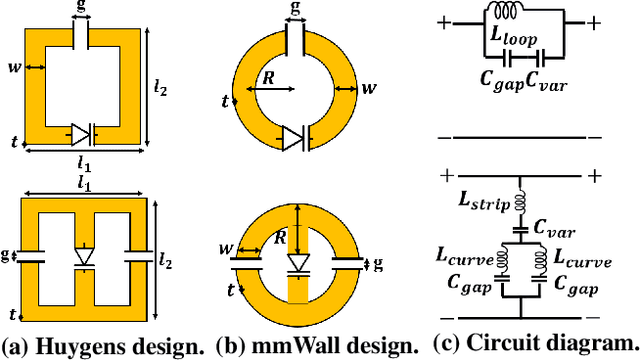
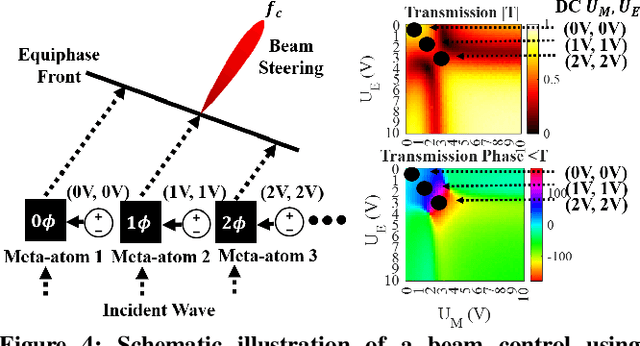
Abstract:To support faster and more efficient networks, mobile operators and service providers are bringing 5G millimeter wave (mmWave) networks indoors. However, due to their high directionality, mmWave links are extremely vulnerable to blockage by walls and human mobility. To address these challenges, we exploit advances in artificially engineered metamaterials, introducing a wall-mounted smart metasurface, called mmWall, that enables a fast mmWave beam relay through the wall and redirects the beam power to another direction when a human body blocks a line-of-sight path. Moreover, our mmWall supports multiple users and fast beam alignment by generating multi-armed beams. We sketch the design of a real-time system by considering (1) how to design a programmable, metamaterial-based surface that refracts the incoming signal to one or more arbitrary directions, and (2) how to split an incoming mmWave beam into multiple outgoing beams and arbitrarily control the beam energy between these beams. Preliminary results show the mmWall metasurface steers the outgoing beam in a full 360-degrees, with an 89.8% single-beam efficiency and 74.5% double-beam efficiency.
 Add to Chrome
Add to Chrome Add to Firefox
Add to Firefox Add to Edge
Add to Edge